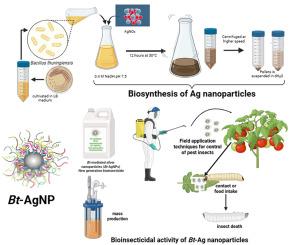Biogenic synthesis of silver nanoparticles using Bacillus thuringiensis and its secondary metabolites; New generation bioinsecticides, current trends and future perspectives
IF 7.9
Q1 ENGINEERING, MULTIDISCIPLINARY
引用次数: 0
Abstract
The growing demand for sustainable pest control solutions has propelled the development of biologically derived nanobiopesticides, with Bacillus thuringiensis (Bt)-mediated silver nanoparticles (AgNPs) emerging as a promising innovation. Silver NPs are silver oxide dominated. This review addresses the green synthesis of Ag₂ONPs utilizing Bt and its chitinase enzyme. Here we are emphasizing the unique physicochemical and bioactive characteristics that position these nanoparticles at the forefront of next-generation biopesticides. Bt-Ag₂ONPs combine the entomopathogenic potency of Bt with the oxidative and antimicrobial properties of silver, yielding dual-action nanoconjugates that demonstrate enhanced insecticidal activity, reduced pupal emergence, and broad-spectrum efficacy against agricultural pest insects. Bt-Ag₂ONPs demonstrated significantly higher insecticidal efficacy against Tribolium castaneum compared to Bt alone or commercial Ag₂ONPs. These nanoparticles also markedly suppressed pupal emergence, underscoring their potent developmental inhibition effects. Furthermore, the biosynthesis process is environmentally benign, cost-effective, and highly tunable, allowing for control over nanoparticle size, dispersity, and stability. There are several limitations about their ecotoxicology and regulations that are discussed in this review. The review also addresses current trends in formulation science, including smart delivery systems and precision-targeted applications as well as future research directions in synthetic biology and ecotoxicological assessment. Bt-derived Ag₂ONPs represent a powerful, multifaceted tool for integrated pest management strategies, offering a compelling alternative to conventional chemical pesticides and laying the groundwork for more resilient and sustainable agroecosystems.

苏云金芽孢杆菌及其次生代谢产物生物合成纳米银的研究新一代生物杀虫剂,现状趋势及未来展望
对可持续虫害防治解决方案日益增长的需求推动了生物衍生纳米农药的发展,苏云金芽孢杆菌(Bt)介导的银纳米颗粒(AgNPs)成为一项有前途的创新。银NPs以氧化银为主。本文综述了利用Bt及其几丁质酶绿色合成Ag₂ONPs的研究进展。在这里,我们强调独特的物理化学和生物活性特性,使这些纳米颗粒处于下一代生物农药的前沿。Bt- ag 2 ONPs结合了Bt的昆虫致病能力与银的氧化和抗菌性能,产生双作用纳米偶联物,具有增强的杀虫活性,减少蛹羽化,对农业害虫具有广谱功效。Bt-Ag 2 ONPs对castaneum的杀虫效果明显高于单独使用Bt或商业化的Ag 2 ONPs。这些纳米颗粒也显著抑制蛹的羽化,强调其强大的发育抑制作用。此外,生物合成过程对环境无害,具有成本效益,并且高度可调,可以控制纳米颗粒的大小,分散性和稳定性。本文对其生态毒理学和调控方面的局限性进行了讨论。综述还讨论了配方科学的当前趋势,包括智能给药系统和精确靶向应用,以及合成生物学和生态毒理学评估的未来研究方向。bt衍生的ag2 ONPs是病虫害综合治理战略的一个强大的、多方面的工具,提供了传统化学农药的令人信服的替代品,并为更具弹性和可持续的农业生态系统奠定了基础。
本文章由计算机程序翻译,如有差异,请以英文原文为准。
求助全文
约1分钟内获得全文
求助全文
来源期刊

Results in Engineering
Engineering-Engineering (all)
CiteScore
5.80
自引率
34.00%
发文量
441
审稿时长
47 days
 求助内容:
求助内容: 应助结果提醒方式:
应助结果提醒方式:


